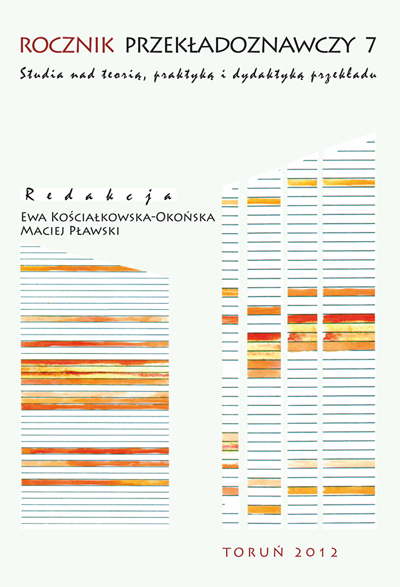Norma w przekładzie: ułatwienie pracy czy przeszkoda dla tłumacza?
DOI:
https://doi.org/10.12775/RP.2012.005Słowa kluczowe
norma tłumaczeniowa, tłumaczenie ustne, tłumaczenie naturalne, tłumaczenie profesionalneAbstrakt
Norma tłumaczeniowa jest zjawiskiem w przekładzie, o którym zaczęto mówić już w latach 70. ubiegłego stulecia. W badaniach nad przekładem ustnym natomiast pojęcie normy pojawia się dopiero w następnej dekadzie. Niniejszy artykuł poświęcony jest znaczeniu i funkcjonowaniu normy w przekładzie ustnym, ze szczególnym uwzględnieniem typu tłumacza (eksperta lub nieeksperta) odwołującego się (bądź też nie) do normy w trakcie procesu tłumaczeniowego.
Bibliografia
Berk-Seligson, S., 1990, The Bilingual Courtroom: Court Interpreters in the Judicial Process, Chicago–London, University of Chicago Press.
Buhler, H., 1986, „Linguistic (semantic) and extra-linguistic (pragmatic) criteria for the evaluation of conference interpretation and interpreters”, Multilingua 5, 4, s. 231–235.
Chesterman, A., 1993, „From ‘is’ to ‘ought’: translation laws, norms and strategies”, Target, 5/1, s. 1–20.
Danks, J.H., (red.), 1997, Cognitive Processes in Translation and Interpreting, Thousand Oaks, London, New Delhi, Sage.
Diriker, E., 1999, „Problematizing the discourse on interpreting – A quest for norms in simultaneous interpreting”, TexTconTexT, 132, s. 73–90.
Ericsson, K.A., (red.), 2009, The Cambridge Handbook of Expertise and Expert Performance, Cambridge: Cambridge University Press.
Fenton, S., 1997, „The role of the interpreter in the adversarial courtroom”, [w:] The Critical Link: Interpreters in the Community, R. Roberts i S. Carr (red.), Amsterdam–Philadelphia, John Benjamins, s. 29–34.
Gile, D., 1995, Basic Concepts and Models for Interpreter and Translator Training, Amsterdam–Philadelphia, John Benjamins.
Harris, B., 1990, „Norms in interpretation”, Target, 2, s. 115–119.
Holz-Manttari, J., 1984, Translatorisches Handeln. Theorie und Methode, Helsinki, Sumoalainen Tiedeakatemia.
Inghilleri, M., 2004, „Aligning Macro- and Micro-Dimensions in Interpreting Research”, [w:] Translation Research and Interpreting Research. Traditions,gaps and synergies, Ch. Schaff ner (red.), Clevedon, Multilingual Matters, s. 71–77.
Jaaskelainen, R., 1993, „Investigating translation strategies”, [w:] Recent Trends in Empirical Translation Research, S. Tirkkonen-Condit i J. Laffling (red.), Joensuu, University of Joensuu Press, s. 99–120.
Jaaskelainen, R., 1997, Tapping the process: An explorative study of the cognitive and affective factors involved in translating, rozprawa doktorska, Joensuu, University of Joensuu Press.
Johnson-Laird, P.N., 1983, Mental models: Towards a cognitive science of language, inference, and consciousness, Cambridge, MA: Harvard University Press.
Kadric, M., Kaindl K., Pochhacker F. (red.), 2000, Translationswissenschaft , Tubingen, Stauff enburg Verlag.
Kiraly, D.C., 1997, Think-Aloud Protocols and the Construction of a Professional Translator Self-Concept, [w:] Cognitive Processes in Translation and Interpreting, red. J.H. Danks i in., Thousand Oaks–London–New Delhi, Sage, s. 137–160.
Kurz, I., 1989, „Conference Interpreting: User Expectations”, [w:] Coming of Age: Proceedings of the 30th Annual Conference of the American Translators Association, D.L. Hammond (red.), Medford–New Jersey, Learned Information, s. 143–148.
Kurz, I., 1993, „Conference Interpretation: Expectations of different user groups”, The Interpreter’s Newsletter, 5, Universita degli Studi di Trieste, SSLM, s. 13–21.
Kussmaul, P., 1995, Training the Translator, Amsterdam–Philadelphia, John Benjamins.
Lorscher, W., 1991, Translation Performance, Translation Process, and Translation Strategies, Tubingen, Gunter Narr Verlag.
Lewandowska-Tomaszczyk, B., Thelen, M. (red.), 1992, Translation and Meaning, part 2, Rijkshogeschool Maastricht, Faculty of Translation and Interpreting.
Mesa, A.-M., 2000, „The Cultural Interpreter: An Appreciated Professional. Results of a Study on Interpreting Services: Client, Health Care Worker and Interpreter Points of View”, [w:] The Critical Link 2: Interpreters in the Community, R.P. Roberts i S.E. Carr (red.), Amsterdam–Philadephia, John Benjamins, s. 67–79.
Mikkelson, H., 2000, Introduction to Court Interpreting, Manchester, St Jerome Publishing.
Mikkelson, H., 2008, „Evolving views of the court interpreter’s role: Between Scylla and Charybdis”, [w:] Crossing Borders in Community Interpreting, C. Valero-Garces, A. Martin (red.), Amsterdam–Philadelphia, John Benjamins, s. 81–97.
Moser-Mercer, B., 1997, „The expert-novice paradigm in interpreting research”, [w:] Translationsdidaktik, E. Fleischmann, W. Kurz i P. Schmitt (red.), Tubingen, Gunter Narr Verlag, s. 255–261.
Moser-Mercer, B., 2000, „The rocky road to expertise in interpreting: eliciting knowledge from learners”, [w:] Translationswissenschaft , M. Kadric, K. Kaindl, F. Pochhacker (red.), Tubingen, Stauff enburg Verlag, s. 339–350.
Niska, H. 1995, „Just interpreting: Role conflicts and discourse types in court interpreting”, [w:] Translation and the Law, M. Morris (red.), Amsterdam–Philadelphia, John Benjamins, s. 293–316.
Pochhacker, F., 2000, „The Community Interpreter’s Task: Self-Perception and Provider Views”, [w:] The Critical Link 2: Interpreters in the Community, R.P. Roberts i S.E. Carr (red.), Amsterdam–Philadephia, John Benjamins, s. 49–65.
Pym, A., 1992, Translation and Text Transfer, Frankfurt am Main, Peter Lang. Risku H., 1998, Translatorische Kompetenz. Kognitive Grundlagen des Ubersetzens als Expertentatigkeit, Tubingen, Stauff enburg Verlag.
Schaffner, Ch., 1999, Translation and norms, Clevedon, Multilingual Matters.
Schaffner, Ch. (red.), 2004, Translation Research and Interpreting Research. Traditions, gaps and synergies, Clevedon, Multilingual Matters.
Schjoldager, A., 2002, „An exploratory study of translational norms in simultaneous interpreting: methodological reflections”, [w:] The Interpreting Studies Reader, F. Pochhacker i M. Shlesinger (red.), London, Routledge, s. 300–311.
Shlesinger, M., 1989, „Extending the theory of translation to interpretation: Norms as a case in Point”, Target, 1: 1, s. 111–15.
Shlesinger, M., 2000, „Interpreting as a Cognitive Process: How can we know what really happens?”, [w:] Tapping and mapping the processes of translation and interpreting: outlooks on empirical research, red. S. Tirkkonen-Condit i R. Jaaskelainen (red.), Amsterdam, John Benjamins, s. 3–15.
Shreve, G.M., 1997, Cognition and the Evolution of Translation Competence, [w:] Cognitive Processes in Translation and Interpreting, J.H. Danks (red.), Thousand Oaks–London–New Delhi, Sage, s. 120–137.
Sternberg, R.J., 1999, Cognitive Psychology, Fort Worth, Harcourt Brace College Publishers.
Tirkkonen-Condit S., 1992, The Interaction of World Knowledge and Linguistic Knowledge in the Processes of Translation: a think-aloud protocol study, [w:] Translation and Meaning, B. Lewandowska-Tomaszczyk i M. Thelen (red.), cz. 2, Maastricht, Euroterm, s. 433–440.
Tirkkonen-Condit, S., 2000, „Uncertainty in Translation Processes”, [w:] Tapping and Mapping the Processes of Translation and Interpreting, S. Tirkkonen-Condit i R. Jaaskelainen (red.), Amsterdam–Philadelphia, John Benjamins, s. 123–141.
Toury, G., 1980, In Search of a Theory of Translation, Tel Aviv, The Porter Institute for Poetics and Semiotics.
Toury, G., 1995, Descriptive Translation Studies and Beyond, Amsterdam–Philadelphia, John Benjamins Publishing Company.
Wilss, W., 1996, Knowledge and Skills in Translator Behavior, Amsterdam–Philapdelphia, John Benjamins.
Pobrania
Opublikowane
Numer
Dział
Statystyki
Liczba wyświetleń i pobrań: 802
Liczba cytowań: 0



